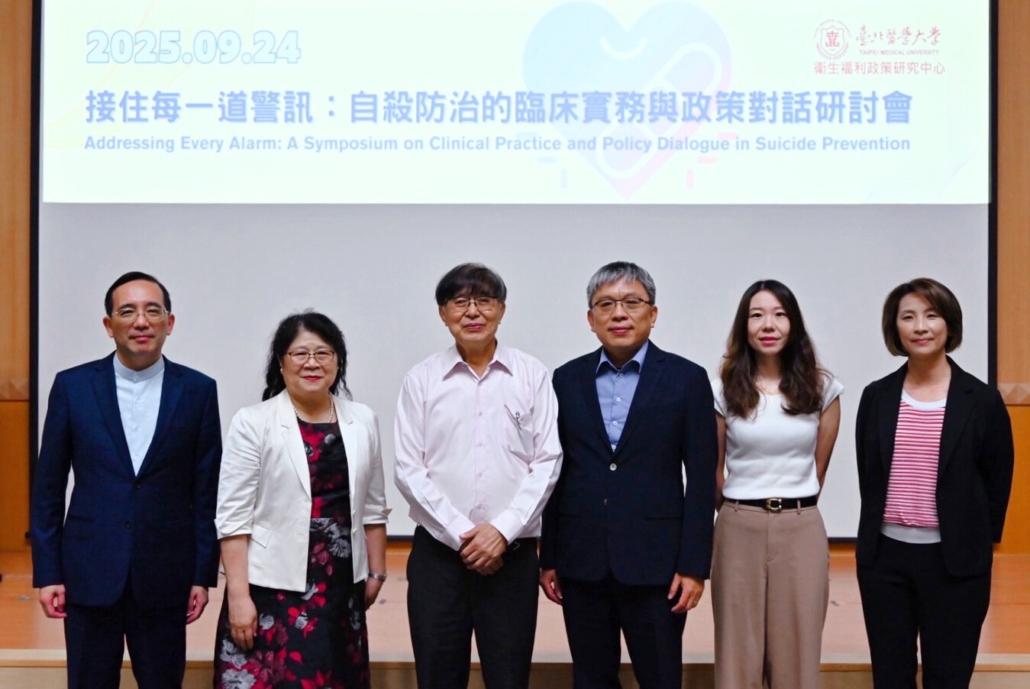:::
On September 24, 2025, the Health and Welfare Policy Research Center of Taipei Medical University convened the seminar “Catching Every Warning Signal: Clinical Practice and Policy Dialogue on Suicide Prevention.”

The event focused on the overall development and systemic responses to suicide prevention, comprehensively examining Taiwan’s current challenges—from government actions and trend data to psychiatric clinical practice and psychological counseling—and putting forward corresponding policy recommendations.
Director Po-Chang Lee, Health and Welfare Policy Research Center, TMU
In his opening remarks, Director Lee emphasized that suicide prevention is a critical issue of public concern, not only relating to public health but also profoundly affecting community safety and people’s mental well-being. This seminar gathered experts from medicine, psychology, civil society, and government to engage in in-depth dialogue on suicide prevention. Director Lee expressed his hope that today’s discussions would unite cross-disciplinary wisdom and efforts to develop more effective prevention strategies.
Chairperson Shu-Chen Lü , Taiwan Suicide Prevention Society
Chairperson Lü highlighted statistics from the National Suicide Prevention Center showing that since 2021, suicide numbers have risen yearly, reaching 4,062 deaths in 2024. Among them, suicides increased by 5.4% in the 15–24 age group, 9.2% in the 25–44 group, and 4.5% in the 45–64 group, indicating growing risks among youth and middle-aged adults. Methods such as hanging, strangulation, and suffocation remain the leading causes, while charcoal burning and jumping from heights have also risen significantly. Men are 1.7 times more likely to die by suicide than women.
The data reveal different causes by age: adolescents are often affected by academic pressure, peer and family issues; middle-aged groups face relationship stress, workplace pressure, and debt; while older adults are often burdened by chronic illness. Over 40% of suicides are associated with depression or other mental illnesses. However, only 26.9% of suicide decedents had ever been included in the suicide follow-up care system, leaving many—especially men and older adults—outside the safety net. Chairperson Lü stressed that suicide prevention requires public-private collaboration. Although most citizens acknowledge its importance, the “2024 Suicide Prevention Awareness Survey” showed low awareness of resources such as the 1925 hotline and low willingness to seek help. She called for society to act as “gatekeepers” through cross-sector cooperation to bring hope to those in distress.
Director Shan Hung , Addiction and Suicide Prevention Center, TMU Hospital
Director Hung noted that suicide has re-entered Taiwan’s top ten causes of death, underscoring its severity. Suicide, she explained, is not a single act but a process—from ideation to planning, attempt, and outcome. Suicide prevention must advance step by step, from health education and media advocacy, to psychological screening and psychiatric referral for inpatients, to emergency care and follow-up of high-risk individuals.
Research shows the highest suicide risk occurs within 30 days after discharge from the emergency department, making continuous care crucial. Tools such as SADPERSONS and SPS can assist clinicians in identifying high-risk groups. Hung also shared cases showing that schizophrenia, depression, borderline personality disorder, and alcohol use disorder all carry high suicide risks. She advocated for the CARE principle—Calm Concern, Acceptance, Respectful Referral, and Empowerment—as a support framework. Hung concluded: suicide is preventable, and everyone can be a gatekeeper if society works together across sectors to ensure early identification and timely intervention
Senior Clinical Psychologist Huang Yi-Lin, Department of Psychiatry, TMU Hospital
Psychologist Huang emphasized that suicide prevention is not only about stopping death, but also about helping individuals rediscover meaning and value in life. On the frontline, psychologists play a key role in prevention and crisis intervention. By forming therapeutic alliances and offering empathy, they help clients clarify issues, set phased goals, and reframe “wanting to end life” as “wanting to escape pain.” This gradual process nurtures hope and rebuilds purpose.
Huang shared the five principles of Safety Planning: identifying personal warning signs, building coping strategies, strengthening support networks, removing lethal means, and providing professional help channels. The goal is to give individuals a way to hold on through difficult moments. She also recommended policy reforms: integrating psychological counseling into standard care for high-risk cases, establishing regular supervision and occupational support for psychologists, expanding insurance coverage for therapy sessions, building a psychological services platform, adopting the “Zero Suicide” model, and increasing staffing in schools, workplaces, and communities.
Source: Office of Global Engagement & TMU Research Center for Health and Welfare Policy